Comparative Health Systems: Australia, UK, US - PUN640 Health Reform
VerifiedAdded on 2023/06/11
|16
|4284
|466
Essay
AI Summary
This essay provides a comparative analysis of the health systems in Australia, the United Kingdom, and the United States, evaluating their governance, structure, and function. It examines the differences in their approaches to healthcare delivery, including funding models, service provision, and regulatory frameworks. The analysis covers aspects such as Medicare in Australia, the National Health Service in the UK, and the predominantly private health insurance system in the US, highlighting the impact of these differences on healthcare access, cost, and quality. The essay further explores the reasons for these systemic variations, including historical, economic, and political factors, and comparatively evaluates the effectiveness of each system using frameworks like efficiency, effectiveness, and equity. Finally, it describes and critically evaluates proposed or underway reforms in each of the systems, providing a comprehensive overview of the challenges and potential solutions in healthcare delivery.
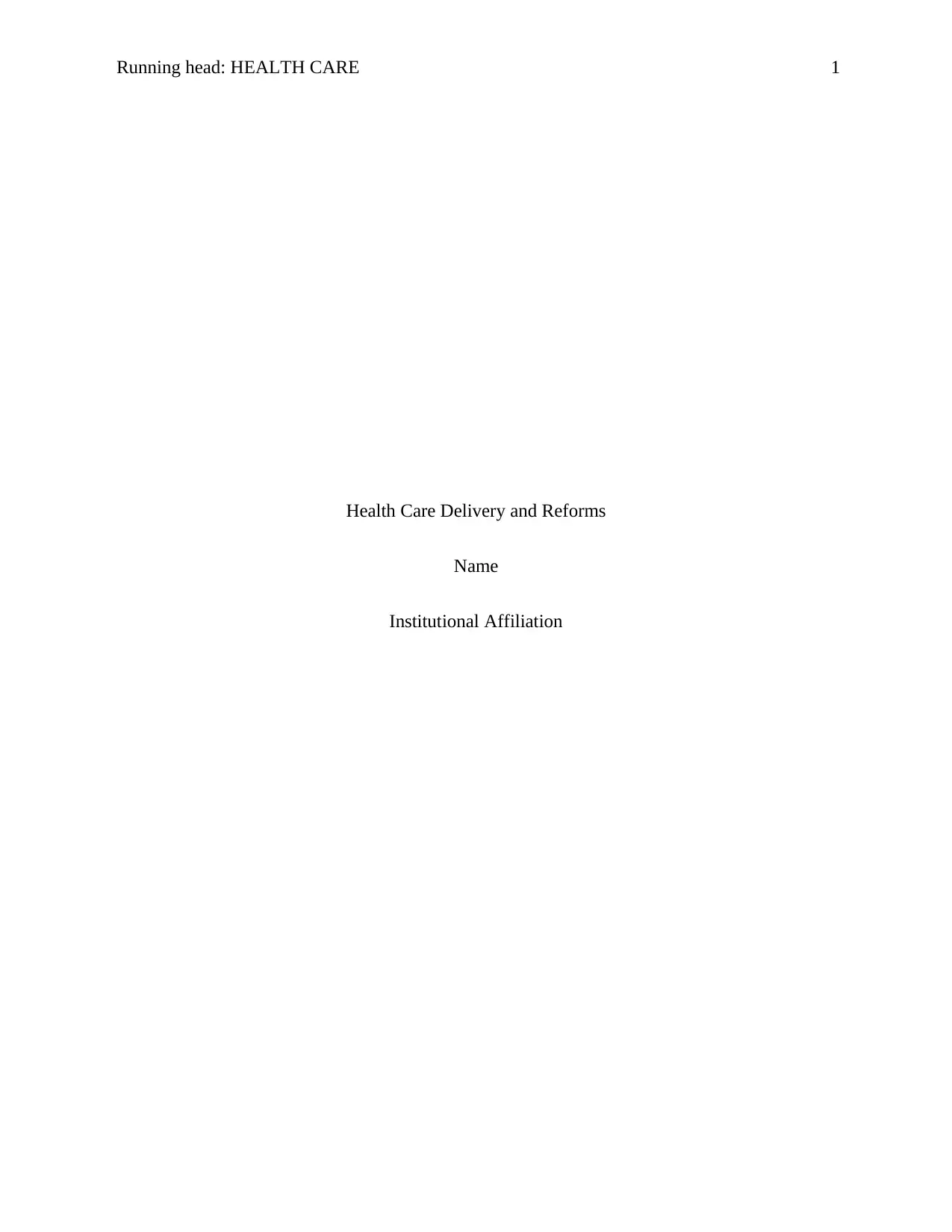
Running head: HEALTH CARE 1
Health Care Delivery and Reforms
Name
Institutional Affiliation
Health Care Delivery and Reforms
Name
Institutional Affiliation
Paraphrase This Document
Need a fresh take? Get an instant paraphrase of this document with our AI Paraphraser
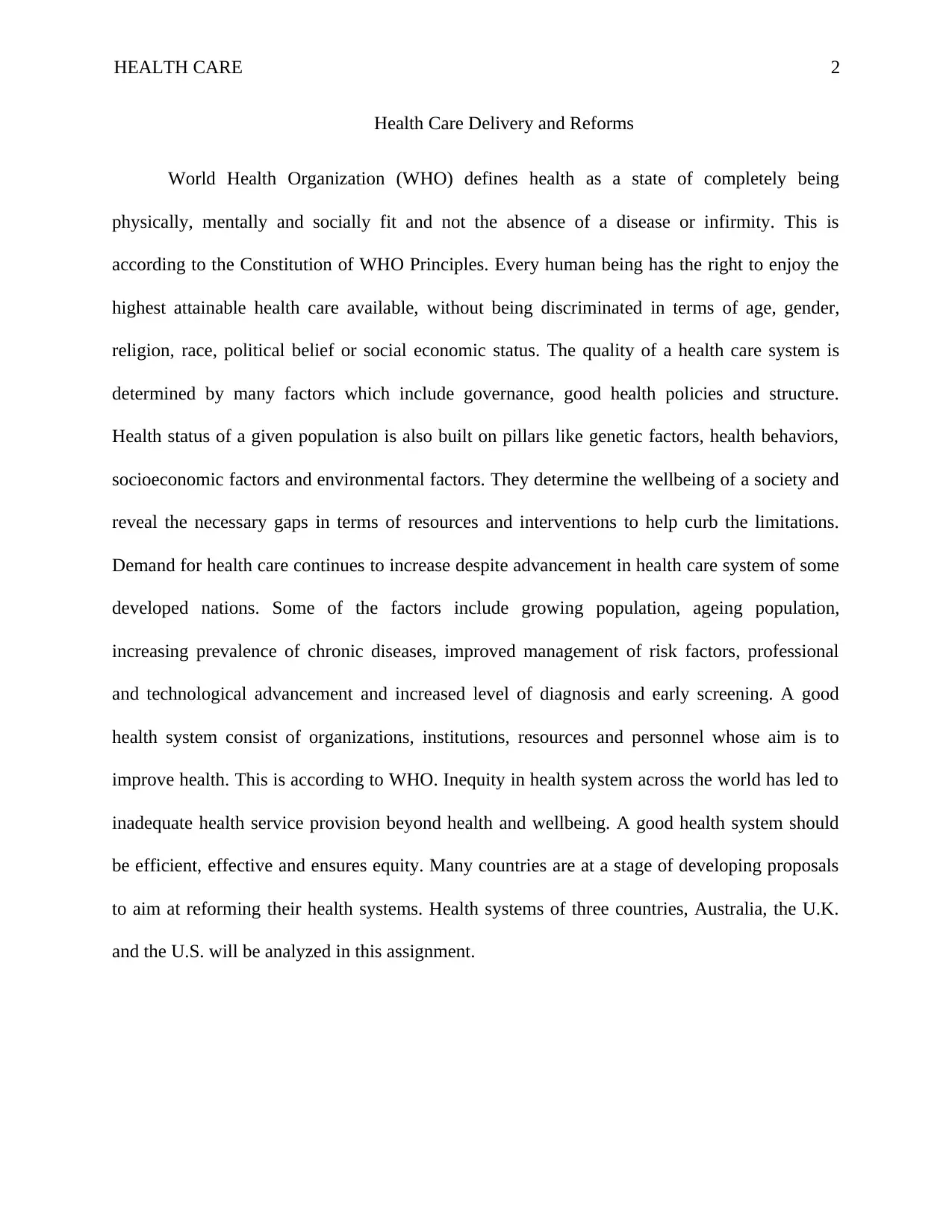
HEALTH CARE 2
Health Care Delivery and Reforms
World Health Organization (WHO) defines health as a state of completely being
physically, mentally and socially fit and not the absence of a disease or infirmity. This is
according to the Constitution of WHO Principles. Every human being has the right to enjoy the
highest attainable health care available, without being discriminated in terms of age, gender,
religion, race, political belief or social economic status. The quality of a health care system is
determined by many factors which include governance, good health policies and structure.
Health status of a given population is also built on pillars like genetic factors, health behaviors,
socioeconomic factors and environmental factors. They determine the wellbeing of a society and
reveal the necessary gaps in terms of resources and interventions to help curb the limitations.
Demand for health care continues to increase despite advancement in health care system of some
developed nations. Some of the factors include growing population, ageing population,
increasing prevalence of chronic diseases, improved management of risk factors, professional
and technological advancement and increased level of diagnosis and early screening. A good
health system consist of organizations, institutions, resources and personnel whose aim is to
improve health. This is according to WHO. Inequity in health system across the world has led to
inadequate health service provision beyond health and wellbeing. A good health system should
be efficient, effective and ensures equity. Many countries are at a stage of developing proposals
to aim at reforming their health systems. Health systems of three countries, Australia, the U.K.
and the U.S. will be analyzed in this assignment.
Health Care Delivery and Reforms
World Health Organization (WHO) defines health as a state of completely being
physically, mentally and socially fit and not the absence of a disease or infirmity. This is
according to the Constitution of WHO Principles. Every human being has the right to enjoy the
highest attainable health care available, without being discriminated in terms of age, gender,
religion, race, political belief or social economic status. The quality of a health care system is
determined by many factors which include governance, good health policies and structure.
Health status of a given population is also built on pillars like genetic factors, health behaviors,
socioeconomic factors and environmental factors. They determine the wellbeing of a society and
reveal the necessary gaps in terms of resources and interventions to help curb the limitations.
Demand for health care continues to increase despite advancement in health care system of some
developed nations. Some of the factors include growing population, ageing population,
increasing prevalence of chronic diseases, improved management of risk factors, professional
and technological advancement and increased level of diagnosis and early screening. A good
health system consist of organizations, institutions, resources and personnel whose aim is to
improve health. This is according to WHO. Inequity in health system across the world has led to
inadequate health service provision beyond health and wellbeing. A good health system should
be efficient, effective and ensures equity. Many countries are at a stage of developing proposals
to aim at reforming their health systems. Health systems of three countries, Australia, the U.K.
and the U.S. will be analyzed in this assignment.
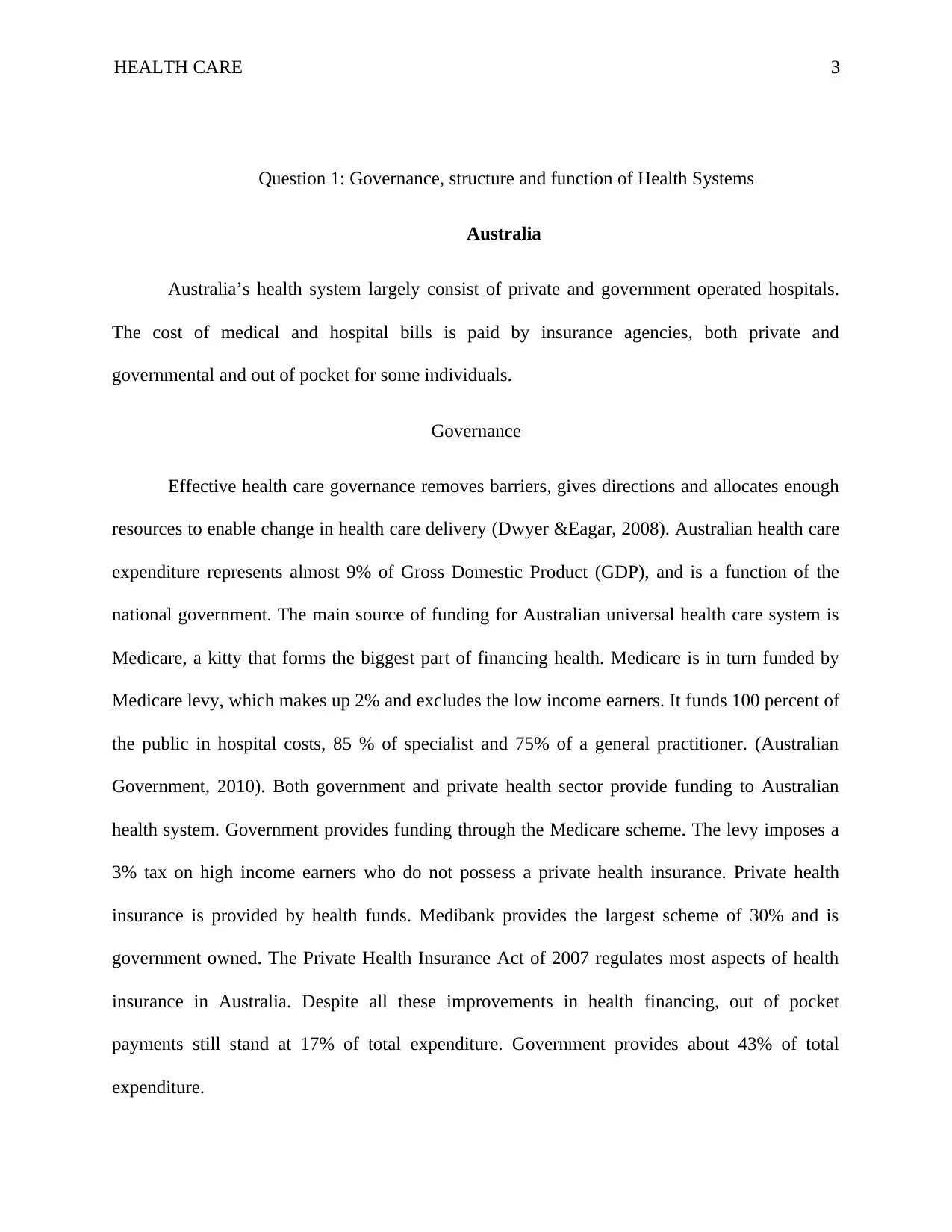
HEALTH CARE 3
Question 1: Governance, structure and function of Health Systems
Australia
Australia’s health system largely consist of private and government operated hospitals.
The cost of medical and hospital bills is paid by insurance agencies, both private and
governmental and out of pocket for some individuals.
Governance
Effective health care governance removes barriers, gives directions and allocates enough
resources to enable change in health care delivery (Dwyer &Eagar, 2008). Australian health care
expenditure represents almost 9% of Gross Domestic Product (GDP), and is a function of the
national government. The main source of funding for Australian universal health care system is
Medicare, a kitty that forms the biggest part of financing health. Medicare is in turn funded by
Medicare levy, which makes up 2% and excludes the low income earners. It funds 100 percent of
the public in hospital costs, 85 % of specialist and 75% of a general practitioner. (Australian
Government, 2010). Both government and private health sector provide funding to Australian
health system. Government provides funding through the Medicare scheme. The levy imposes a
3% tax on high income earners who do not possess a private health insurance. Private health
insurance is provided by health funds. Medibank provides the largest scheme of 30% and is
government owned. The Private Health Insurance Act of 2007 regulates most aspects of health
insurance in Australia. Despite all these improvements in health financing, out of pocket
payments still stand at 17% of total expenditure. Government provides about 43% of total
expenditure.
Question 1: Governance, structure and function of Health Systems
Australia
Australia’s health system largely consist of private and government operated hospitals.
The cost of medical and hospital bills is paid by insurance agencies, both private and
governmental and out of pocket for some individuals.
Governance
Effective health care governance removes barriers, gives directions and allocates enough
resources to enable change in health care delivery (Dwyer &Eagar, 2008). Australian health care
expenditure represents almost 9% of Gross Domestic Product (GDP), and is a function of the
national government. The main source of funding for Australian universal health care system is
Medicare, a kitty that forms the biggest part of financing health. Medicare is in turn funded by
Medicare levy, which makes up 2% and excludes the low income earners. It funds 100 percent of
the public in hospital costs, 85 % of specialist and 75% of a general practitioner. (Australian
Government, 2010). Both government and private health sector provide funding to Australian
health system. Government provides funding through the Medicare scheme. The levy imposes a
3% tax on high income earners who do not possess a private health insurance. Private health
insurance is provided by health funds. Medibank provides the largest scheme of 30% and is
government owned. The Private Health Insurance Act of 2007 regulates most aspects of health
insurance in Australia. Despite all these improvements in health financing, out of pocket
payments still stand at 17% of total expenditure. Government provides about 43% of total
expenditure.
⊘ This is a preview!⊘
Do you want full access?
Subscribe today to unlock all pages.

Trusted by 1+ million students worldwide
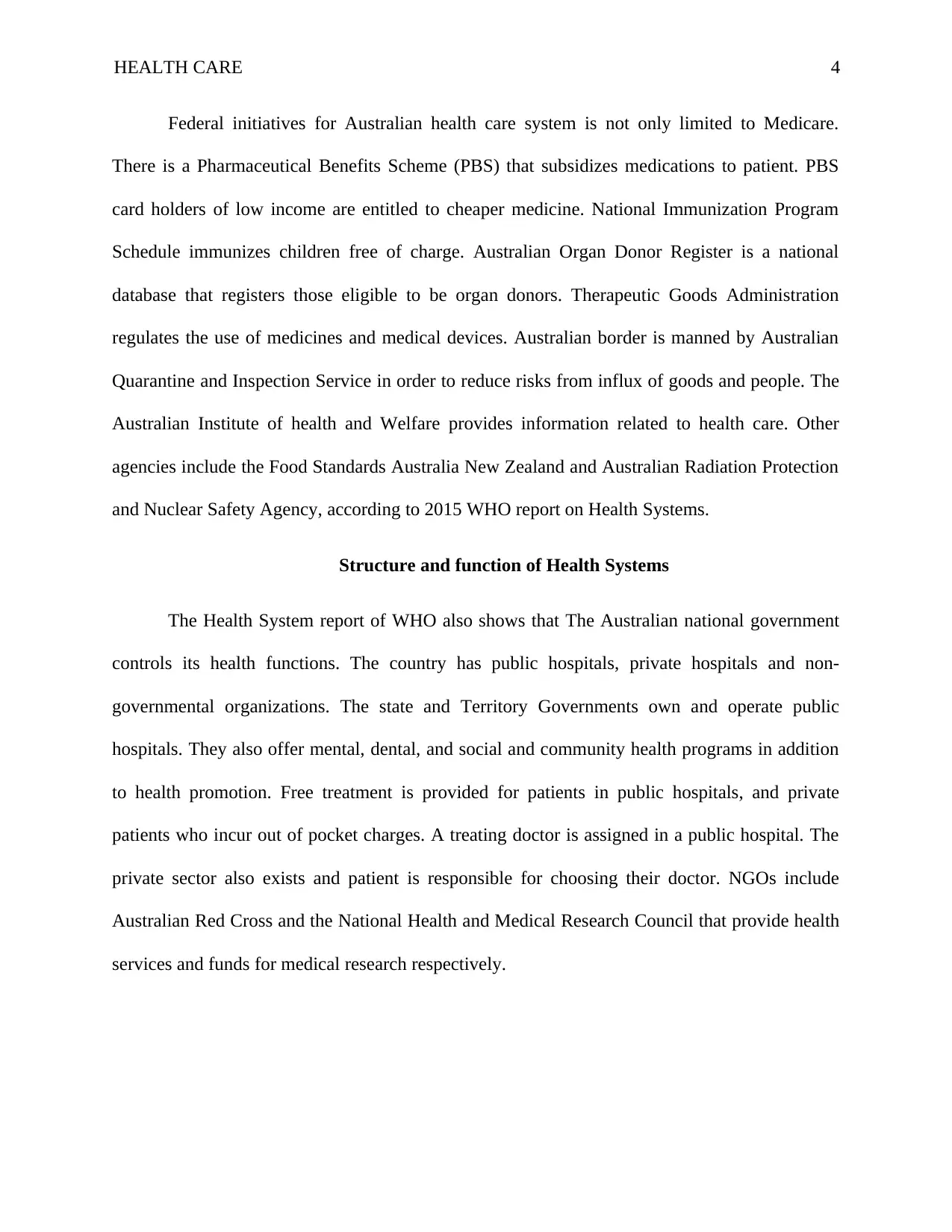
HEALTH CARE 4
Federal initiatives for Australian health care system is not only limited to Medicare.
There is a Pharmaceutical Benefits Scheme (PBS) that subsidizes medications to patient. PBS
card holders of low income are entitled to cheaper medicine. National Immunization Program
Schedule immunizes children free of charge. Australian Organ Donor Register is a national
database that registers those eligible to be organ donors. Therapeutic Goods Administration
regulates the use of medicines and medical devices. Australian border is manned by Australian
Quarantine and Inspection Service in order to reduce risks from influx of goods and people. The
Australian Institute of health and Welfare provides information related to health care. Other
agencies include the Food Standards Australia New Zealand and Australian Radiation Protection
and Nuclear Safety Agency, according to 2015 WHO report on Health Systems.
Structure and function of Health Systems
The Health System report of WHO also shows that The Australian national government
controls its health functions. The country has public hospitals, private hospitals and non-
governmental organizations. The state and Territory Governments own and operate public
hospitals. They also offer mental, dental, and social and community health programs in addition
to health promotion. Free treatment is provided for patients in public hospitals, and private
patients who incur out of pocket charges. A treating doctor is assigned in a public hospital. The
private sector also exists and patient is responsible for choosing their doctor. NGOs include
Australian Red Cross and the National Health and Medical Research Council that provide health
services and funds for medical research respectively.
Federal initiatives for Australian health care system is not only limited to Medicare.
There is a Pharmaceutical Benefits Scheme (PBS) that subsidizes medications to patient. PBS
card holders of low income are entitled to cheaper medicine. National Immunization Program
Schedule immunizes children free of charge. Australian Organ Donor Register is a national
database that registers those eligible to be organ donors. Therapeutic Goods Administration
regulates the use of medicines and medical devices. Australian border is manned by Australian
Quarantine and Inspection Service in order to reduce risks from influx of goods and people. The
Australian Institute of health and Welfare provides information related to health care. Other
agencies include the Food Standards Australia New Zealand and Australian Radiation Protection
and Nuclear Safety Agency, according to 2015 WHO report on Health Systems.
Structure and function of Health Systems
The Health System report of WHO also shows that The Australian national government
controls its health functions. The country has public hospitals, private hospitals and non-
governmental organizations. The state and Territory Governments own and operate public
hospitals. They also offer mental, dental, and social and community health programs in addition
to health promotion. Free treatment is provided for patients in public hospitals, and private
patients who incur out of pocket charges. A treating doctor is assigned in a public hospital. The
private sector also exists and patient is responsible for choosing their doctor. NGOs include
Australian Red Cross and the National Health and Medical Research Council that provide health
services and funds for medical research respectively.
Paraphrase This Document
Need a fresh take? Get an instant paraphrase of this document with our AI Paraphraser
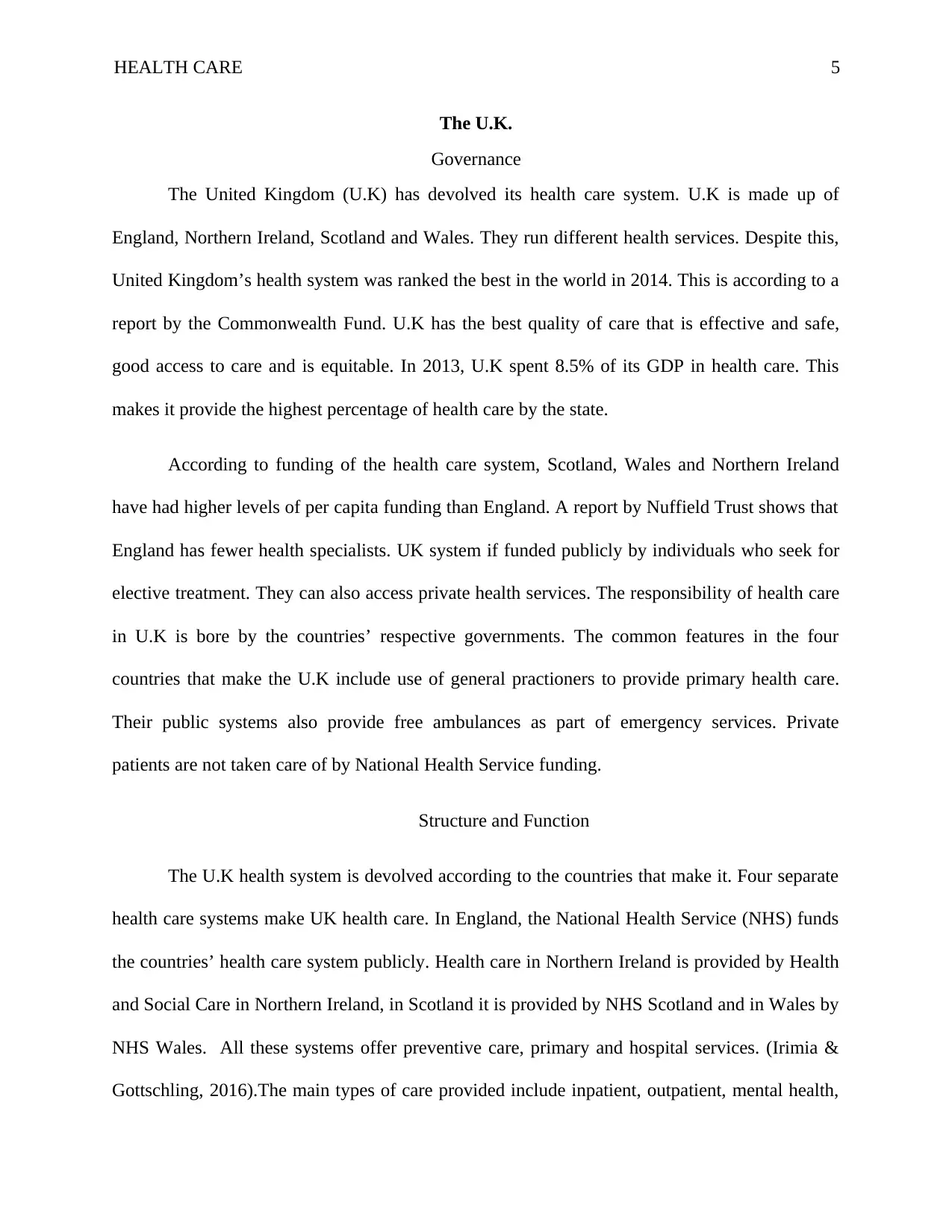
HEALTH CARE 5
The U.K.
Governance
The United Kingdom (U.K) has devolved its health care system. U.K is made up of
England, Northern Ireland, Scotland and Wales. They run different health services. Despite this,
United Kingdom’s health system was ranked the best in the world in 2014. This is according to a
report by the Commonwealth Fund. U.K has the best quality of care that is effective and safe,
good access to care and is equitable. In 2013, U.K spent 8.5% of its GDP in health care. This
makes it provide the highest percentage of health care by the state.
According to funding of the health care system, Scotland, Wales and Northern Ireland
have had higher levels of per capita funding than England. A report by Nuffield Trust shows that
England has fewer health specialists. UK system if funded publicly by individuals who seek for
elective treatment. They can also access private health services. The responsibility of health care
in U.K is bore by the countries’ respective governments. The common features in the four
countries that make the U.K include use of general practioners to provide primary health care.
Their public systems also provide free ambulances as part of emergency services. Private
patients are not taken care of by National Health Service funding.
Structure and Function
The U.K health system is devolved according to the countries that make it. Four separate
health care systems make UK health care. In England, the National Health Service (NHS) funds
the countries’ health care system publicly. Health care in Northern Ireland is provided by Health
and Social Care in Northern Ireland, in Scotland it is provided by NHS Scotland and in Wales by
NHS Wales. All these systems offer preventive care, primary and hospital services. (Irimia &
Gottschling, 2016).The main types of care provided include inpatient, outpatient, mental health,
The U.K.
Governance
The United Kingdom (U.K) has devolved its health care system. U.K is made up of
England, Northern Ireland, Scotland and Wales. They run different health services. Despite this,
United Kingdom’s health system was ranked the best in the world in 2014. This is according to a
report by the Commonwealth Fund. U.K has the best quality of care that is effective and safe,
good access to care and is equitable. In 2013, U.K spent 8.5% of its GDP in health care. This
makes it provide the highest percentage of health care by the state.
According to funding of the health care system, Scotland, Wales and Northern Ireland
have had higher levels of per capita funding than England. A report by Nuffield Trust shows that
England has fewer health specialists. UK system if funded publicly by individuals who seek for
elective treatment. They can also access private health services. The responsibility of health care
in U.K is bore by the countries’ respective governments. The common features in the four
countries that make the U.K include use of general practioners to provide primary health care.
Their public systems also provide free ambulances as part of emergency services. Private
patients are not taken care of by National Health Service funding.
Structure and Function
The U.K health system is devolved according to the countries that make it. Four separate
health care systems make UK health care. In England, the National Health Service (NHS) funds
the countries’ health care system publicly. Health care in Northern Ireland is provided by Health
and Social Care in Northern Ireland, in Scotland it is provided by NHS Scotland and in Wales by
NHS Wales. All these systems offer preventive care, primary and hospital services. (Irimia &
Gottschling, 2016).The main types of care provided include inpatient, outpatient, mental health,
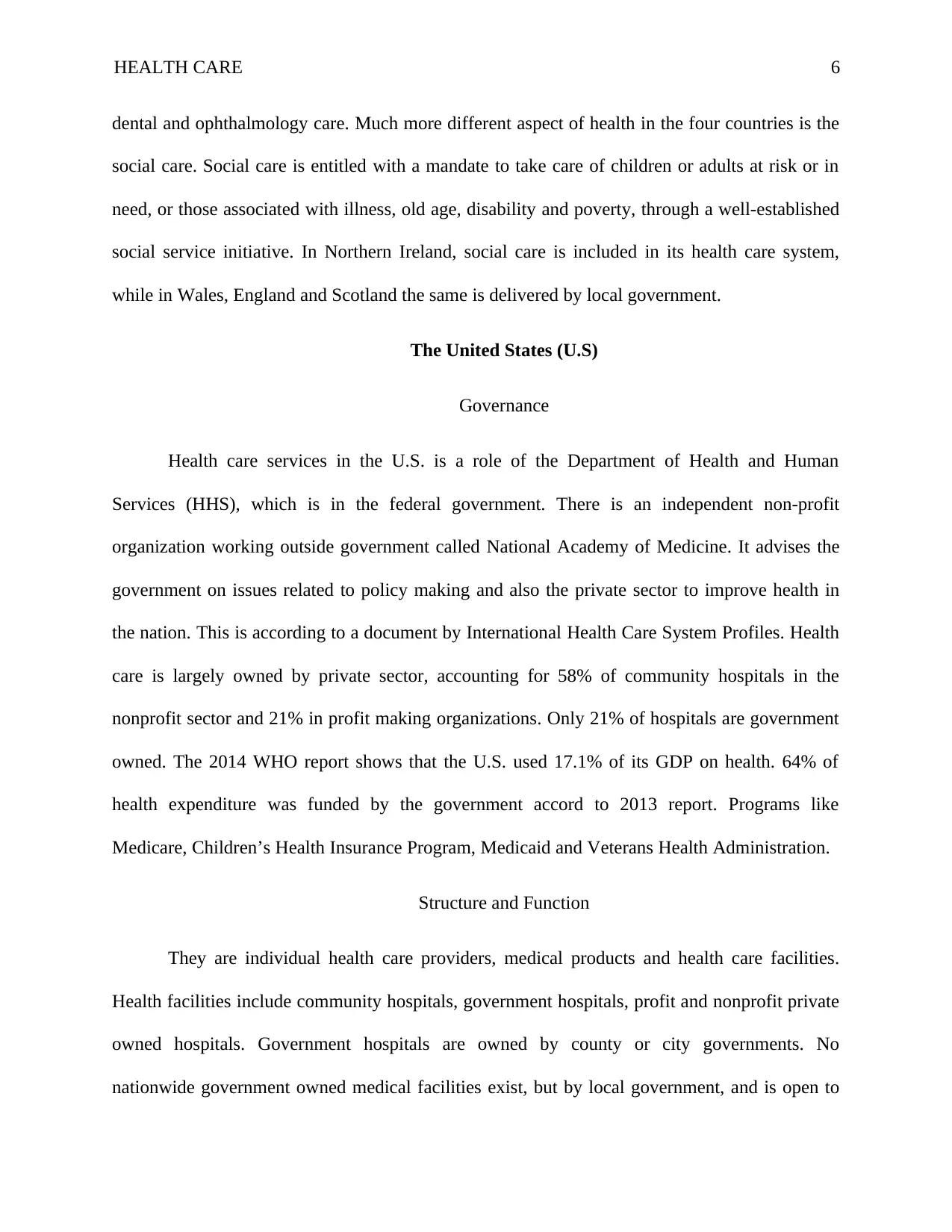
HEALTH CARE 6
dental and ophthalmology care. Much more different aspect of health in the four countries is the
social care. Social care is entitled with a mandate to take care of children or adults at risk or in
need, or those associated with illness, old age, disability and poverty, through a well-established
social service initiative. In Northern Ireland, social care is included in its health care system,
while in Wales, England and Scotland the same is delivered by local government.
The United States (U.S)
Governance
Health care services in the U.S. is a role of the Department of Health and Human
Services (HHS), which is in the federal government. There is an independent non-profit
organization working outside government called National Academy of Medicine. It advises the
government on issues related to policy making and also the private sector to improve health in
the nation. This is according to a document by International Health Care System Profiles. Health
care is largely owned by private sector, accounting for 58% of community hospitals in the
nonprofit sector and 21% in profit making organizations. Only 21% of hospitals are government
owned. The 2014 WHO report shows that the U.S. used 17.1% of its GDP on health. 64% of
health expenditure was funded by the government accord to 2013 report. Programs like
Medicare, Children’s Health Insurance Program, Medicaid and Veterans Health Administration.
Structure and Function
They are individual health care providers, medical products and health care facilities.
Health facilities include community hospitals, government hospitals, profit and nonprofit private
owned hospitals. Government hospitals are owned by county or city governments. No
nationwide government owned medical facilities exist, but by local government, and is open to
dental and ophthalmology care. Much more different aspect of health in the four countries is the
social care. Social care is entitled with a mandate to take care of children or adults at risk or in
need, or those associated with illness, old age, disability and poverty, through a well-established
social service initiative. In Northern Ireland, social care is included in its health care system,
while in Wales, England and Scotland the same is delivered by local government.
The United States (U.S)
Governance
Health care services in the U.S. is a role of the Department of Health and Human
Services (HHS), which is in the federal government. There is an independent non-profit
organization working outside government called National Academy of Medicine. It advises the
government on issues related to policy making and also the private sector to improve health in
the nation. This is according to a document by International Health Care System Profiles. Health
care is largely owned by private sector, accounting for 58% of community hospitals in the
nonprofit sector and 21% in profit making organizations. Only 21% of hospitals are government
owned. The 2014 WHO report shows that the U.S. used 17.1% of its GDP on health. 64% of
health expenditure was funded by the government accord to 2013 report. Programs like
Medicare, Children’s Health Insurance Program, Medicaid and Veterans Health Administration.
Structure and Function
They are individual health care providers, medical products and health care facilities.
Health facilities include community hospitals, government hospitals, profit and nonprofit private
owned hospitals. Government hospitals are owned by county or city governments. No
nationwide government owned medical facilities exist, but by local government, and is open to
⊘ This is a preview!⊘
Do you want full access?
Subscribe today to unlock all pages.

Trusted by 1+ million students worldwide
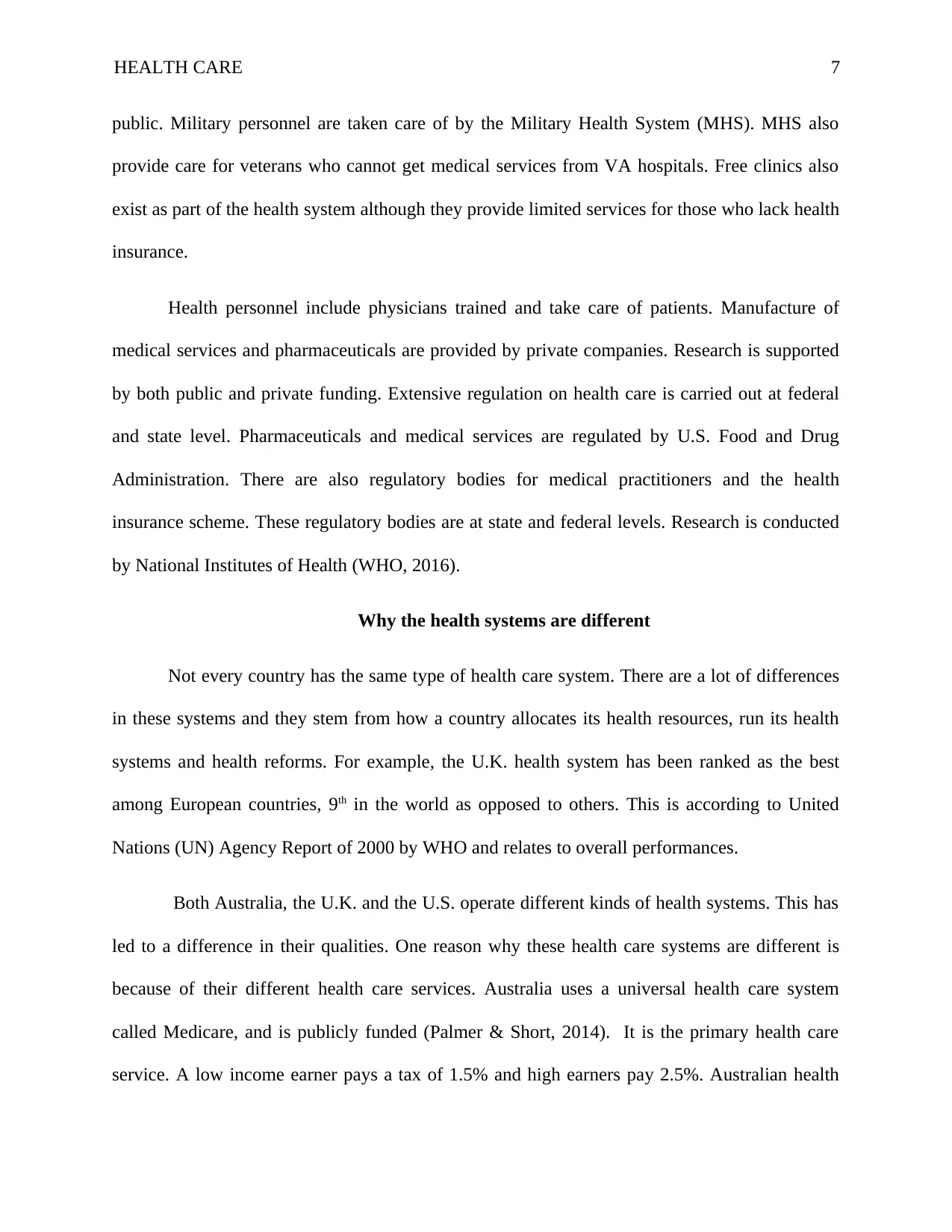
HEALTH CARE 7
public. Military personnel are taken care of by the Military Health System (MHS). MHS also
provide care for veterans who cannot get medical services from VA hospitals. Free clinics also
exist as part of the health system although they provide limited services for those who lack health
insurance.
Health personnel include physicians trained and take care of patients. Manufacture of
medical services and pharmaceuticals are provided by private companies. Research is supported
by both public and private funding. Extensive regulation on health care is carried out at federal
and state level. Pharmaceuticals and medical services are regulated by U.S. Food and Drug
Administration. There are also regulatory bodies for medical practitioners and the health
insurance scheme. These regulatory bodies are at state and federal levels. Research is conducted
by National Institutes of Health (WHO, 2016).
Why the health systems are different
Not every country has the same type of health care system. There are a lot of differences
in these systems and they stem from how a country allocates its health resources, run its health
systems and health reforms. For example, the U.K. health system has been ranked as the best
among European countries, 9th in the world as opposed to others. This is according to United
Nations (UN) Agency Report of 2000 by WHO and relates to overall performances.
Both Australia, the U.K. and the U.S. operate different kinds of health systems. This has
led to a difference in their qualities. One reason why these health care systems are different is
because of their different health care services. Australia uses a universal health care system
called Medicare, and is publicly funded (Palmer & Short, 2014). It is the primary health care
service. A low income earner pays a tax of 1.5% and high earners pay 2.5%. Australian health
public. Military personnel are taken care of by the Military Health System (MHS). MHS also
provide care for veterans who cannot get medical services from VA hospitals. Free clinics also
exist as part of the health system although they provide limited services for those who lack health
insurance.
Health personnel include physicians trained and take care of patients. Manufacture of
medical services and pharmaceuticals are provided by private companies. Research is supported
by both public and private funding. Extensive regulation on health care is carried out at federal
and state level. Pharmaceuticals and medical services are regulated by U.S. Food and Drug
Administration. There are also regulatory bodies for medical practitioners and the health
insurance scheme. These regulatory bodies are at state and federal levels. Research is conducted
by National Institutes of Health (WHO, 2016).
Why the health systems are different
Not every country has the same type of health care system. There are a lot of differences
in these systems and they stem from how a country allocates its health resources, run its health
systems and health reforms. For example, the U.K. health system has been ranked as the best
among European countries, 9th in the world as opposed to others. This is according to United
Nations (UN) Agency Report of 2000 by WHO and relates to overall performances.
Both Australia, the U.K. and the U.S. operate different kinds of health systems. This has
led to a difference in their qualities. One reason why these health care systems are different is
because of their different health care services. Australia uses a universal health care system
called Medicare, and is publicly funded (Palmer & Short, 2014). It is the primary health care
service. A low income earner pays a tax of 1.5% and high earners pay 2.5%. Australian health
Paraphrase This Document
Need a fresh take? Get an instant paraphrase of this document with our AI Paraphraser
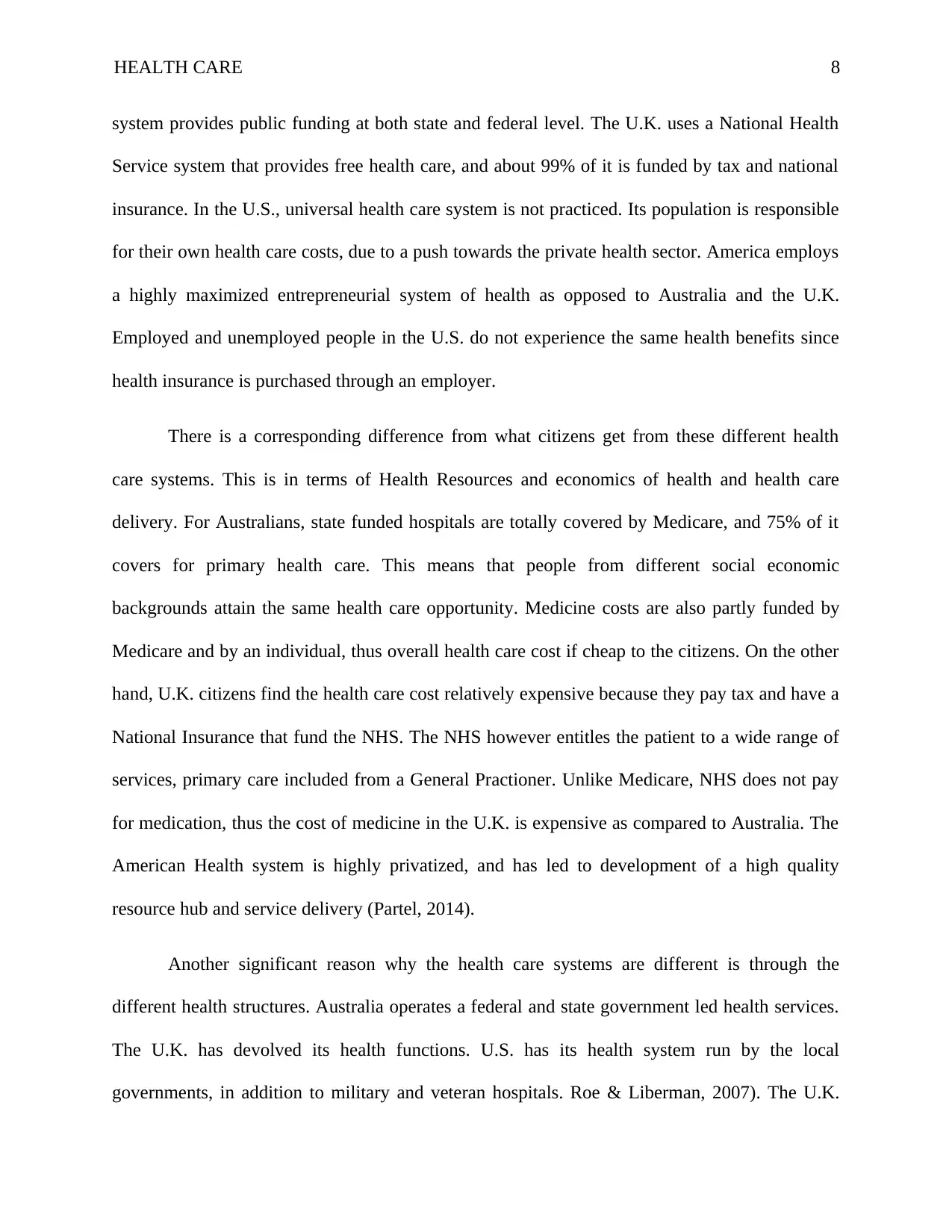
HEALTH CARE 8
system provides public funding at both state and federal level. The U.K. uses a National Health
Service system that provides free health care, and about 99% of it is funded by tax and national
insurance. In the U.S., universal health care system is not practiced. Its population is responsible
for their own health care costs, due to a push towards the private health sector. America employs
a highly maximized entrepreneurial system of health as opposed to Australia and the U.K.
Employed and unemployed people in the U.S. do not experience the same health benefits since
health insurance is purchased through an employer.
There is a corresponding difference from what citizens get from these different health
care systems. This is in terms of Health Resources and economics of health and health care
delivery. For Australians, state funded hospitals are totally covered by Medicare, and 75% of it
covers for primary health care. This means that people from different social economic
backgrounds attain the same health care opportunity. Medicine costs are also partly funded by
Medicare and by an individual, thus overall health care cost if cheap to the citizens. On the other
hand, U.K. citizens find the health care cost relatively expensive because they pay tax and have a
National Insurance that fund the NHS. The NHS however entitles the patient to a wide range of
services, primary care included from a General Practioner. Unlike Medicare, NHS does not pay
for medication, thus the cost of medicine in the U.K. is expensive as compared to Australia. The
American Health system is highly privatized, and has led to development of a high quality
resource hub and service delivery (Partel, 2014).
Another significant reason why the health care systems are different is through the
different health structures. Australia operates a federal and state government led health services.
The U.K. has devolved its health functions. U.S. has its health system run by the local
governments, in addition to military and veteran hospitals. Roe & Liberman, 2007). The U.K.
system provides public funding at both state and federal level. The U.K. uses a National Health
Service system that provides free health care, and about 99% of it is funded by tax and national
insurance. In the U.S., universal health care system is not practiced. Its population is responsible
for their own health care costs, due to a push towards the private health sector. America employs
a highly maximized entrepreneurial system of health as opposed to Australia and the U.K.
Employed and unemployed people in the U.S. do not experience the same health benefits since
health insurance is purchased through an employer.
There is a corresponding difference from what citizens get from these different health
care systems. This is in terms of Health Resources and economics of health and health care
delivery. For Australians, state funded hospitals are totally covered by Medicare, and 75% of it
covers for primary health care. This means that people from different social economic
backgrounds attain the same health care opportunity. Medicine costs are also partly funded by
Medicare and by an individual, thus overall health care cost if cheap to the citizens. On the other
hand, U.K. citizens find the health care cost relatively expensive because they pay tax and have a
National Insurance that fund the NHS. The NHS however entitles the patient to a wide range of
services, primary care included from a General Practioner. Unlike Medicare, NHS does not pay
for medication, thus the cost of medicine in the U.K. is expensive as compared to Australia. The
American Health system is highly privatized, and has led to development of a high quality
resource hub and service delivery (Partel, 2014).
Another significant reason why the health care systems are different is through the
different health structures. Australia operates a federal and state government led health services.
The U.K. has devolved its health functions. U.S. has its health system run by the local
governments, in addition to military and veteran hospitals. Roe & Liberman, 2007). The U.K.
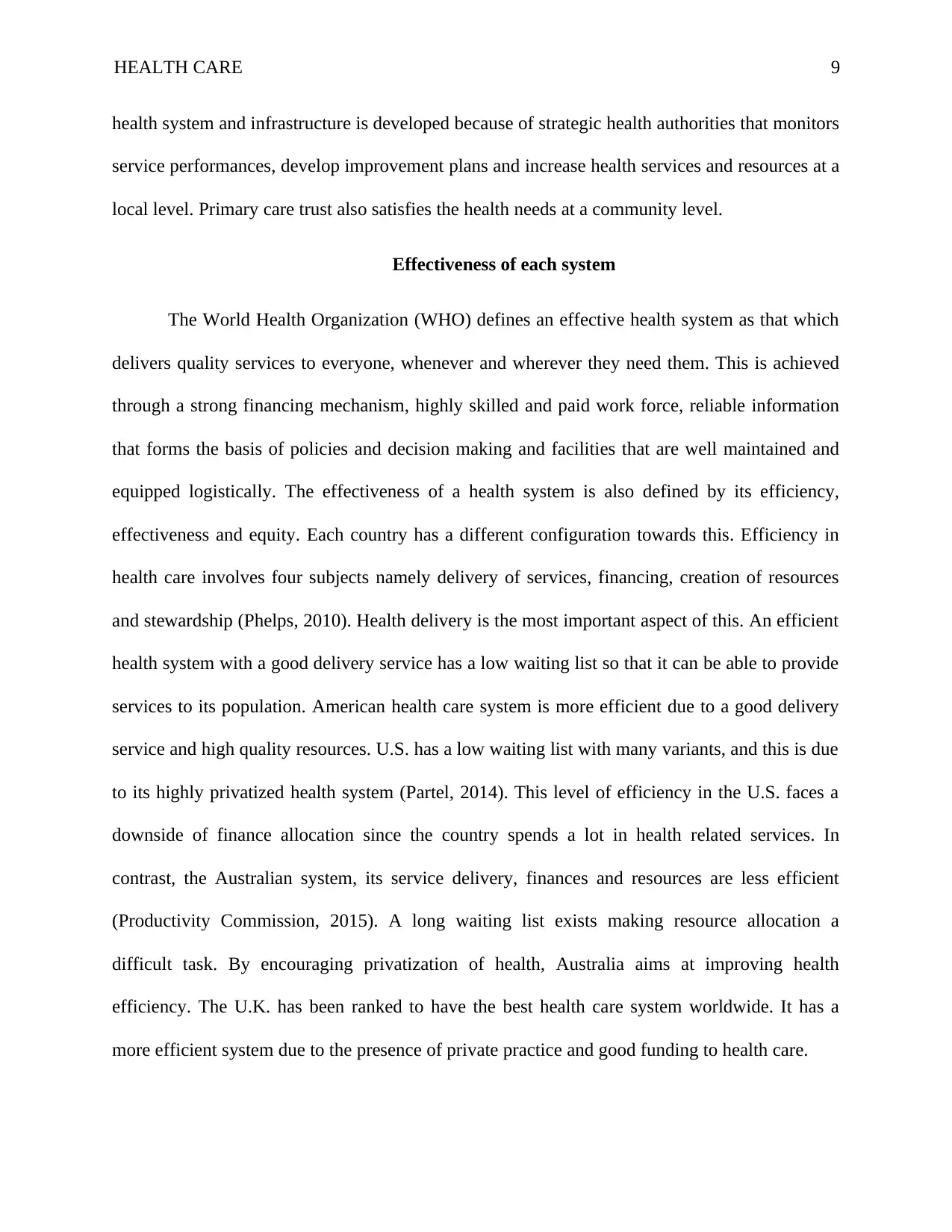
HEALTH CARE 9
health system and infrastructure is developed because of strategic health authorities that monitors
service performances, develop improvement plans and increase health services and resources at a
local level. Primary care trust also satisfies the health needs at a community level.
Effectiveness of each system
The World Health Organization (WHO) defines an effective health system as that which
delivers quality services to everyone, whenever and wherever they need them. This is achieved
through a strong financing mechanism, highly skilled and paid work force, reliable information
that forms the basis of policies and decision making and facilities that are well maintained and
equipped logistically. The effectiveness of a health system is also defined by its efficiency,
effectiveness and equity. Each country has a different configuration towards this. Efficiency in
health care involves four subjects namely delivery of services, financing, creation of resources
and stewardship (Phelps, 2010). Health delivery is the most important aspect of this. An efficient
health system with a good delivery service has a low waiting list so that it can be able to provide
services to its population. American health care system is more efficient due to a good delivery
service and high quality resources. U.S. has a low waiting list with many variants, and this is due
to its highly privatized health system (Partel, 2014). This level of efficiency in the U.S. faces a
downside of finance allocation since the country spends a lot in health related services. In
contrast, the Australian system, its service delivery, finances and resources are less efficient
(Productivity Commission, 2015). A long waiting list exists making resource allocation a
difficult task. By encouraging privatization of health, Australia aims at improving health
efficiency. The U.K. has been ranked to have the best health care system worldwide. It has a
more efficient system due to the presence of private practice and good funding to health care.
health system and infrastructure is developed because of strategic health authorities that monitors
service performances, develop improvement plans and increase health services and resources at a
local level. Primary care trust also satisfies the health needs at a community level.
Effectiveness of each system
The World Health Organization (WHO) defines an effective health system as that which
delivers quality services to everyone, whenever and wherever they need them. This is achieved
through a strong financing mechanism, highly skilled and paid work force, reliable information
that forms the basis of policies and decision making and facilities that are well maintained and
equipped logistically. The effectiveness of a health system is also defined by its efficiency,
effectiveness and equity. Each country has a different configuration towards this. Efficiency in
health care involves four subjects namely delivery of services, financing, creation of resources
and stewardship (Phelps, 2010). Health delivery is the most important aspect of this. An efficient
health system with a good delivery service has a low waiting list so that it can be able to provide
services to its population. American health care system is more efficient due to a good delivery
service and high quality resources. U.S. has a low waiting list with many variants, and this is due
to its highly privatized health system (Partel, 2014). This level of efficiency in the U.S. faces a
downside of finance allocation since the country spends a lot in health related services. In
contrast, the Australian system, its service delivery, finances and resources are less efficient
(Productivity Commission, 2015). A long waiting list exists making resource allocation a
difficult task. By encouraging privatization of health, Australia aims at improving health
efficiency. The U.K. has been ranked to have the best health care system worldwide. It has a
more efficient system due to the presence of private practice and good funding to health care.
⊘ This is a preview!⊘
Do you want full access?
Subscribe today to unlock all pages.

Trusted by 1+ million students worldwide
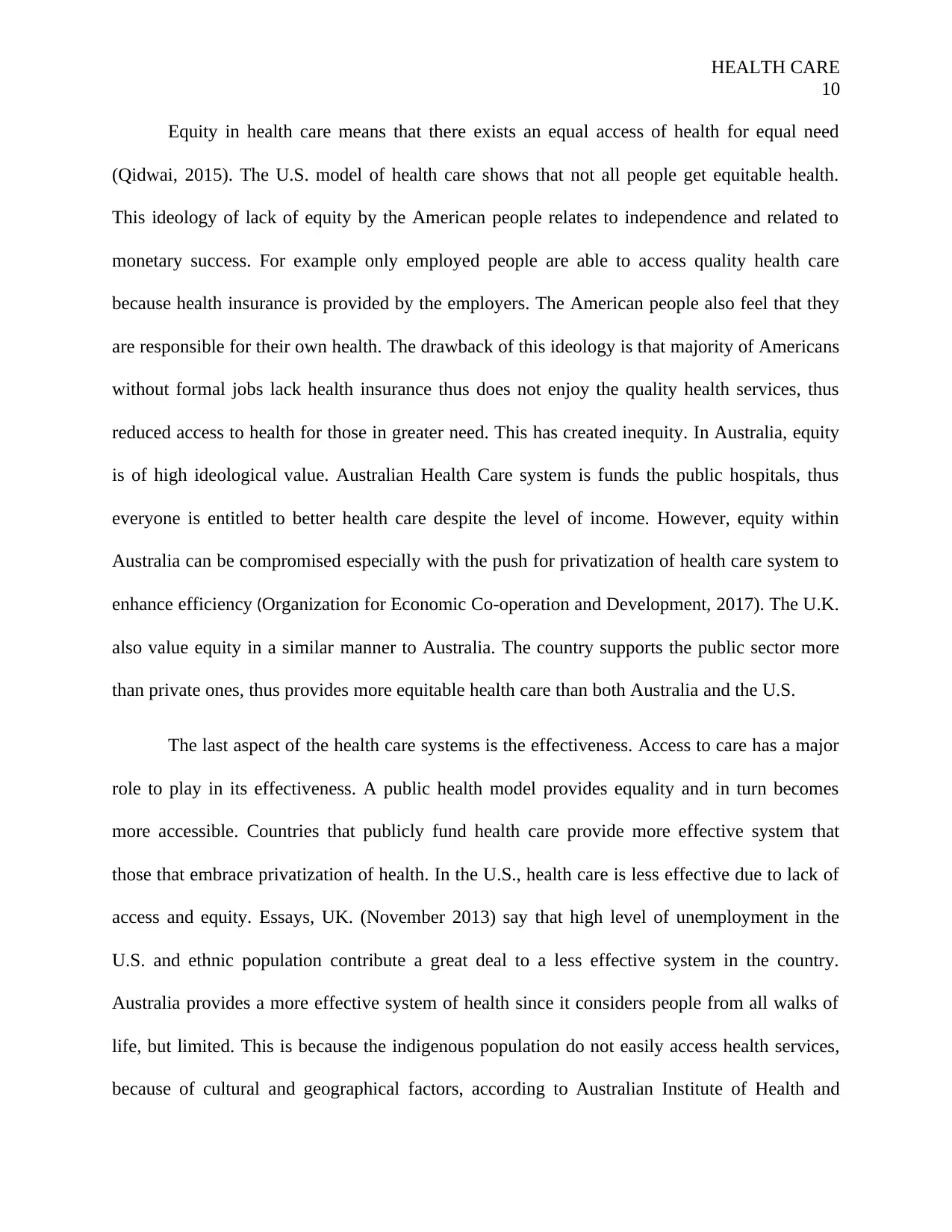
HEALTH CARE
10
Equity in health care means that there exists an equal access of health for equal need
(Qidwai, 2015). The U.S. model of health care shows that not all people get equitable health.
This ideology of lack of equity by the American people relates to independence and related to
monetary success. For example only employed people are able to access quality health care
because health insurance is provided by the employers. The American people also feel that they
are responsible for their own health. The drawback of this ideology is that majority of Americans
without formal jobs lack health insurance thus does not enjoy the quality health services, thus
reduced access to health for those in greater need. This has created inequity. In Australia, equity
is of high ideological value. Australian Health Care system is funds the public hospitals, thus
everyone is entitled to better health care despite the level of income. However, equity within
Australia can be compromised especially with the push for privatization of health care system to
enhance efficiency (Organization for Economic Co-operation and Development, 2017). The U.K.
also value equity in a similar manner to Australia. The country supports the public sector more
than private ones, thus provides more equitable health care than both Australia and the U.S.
The last aspect of the health care systems is the effectiveness. Access to care has a major
role to play in its effectiveness. A public health model provides equality and in turn becomes
more accessible. Countries that publicly fund health care provide more effective system that
those that embrace privatization of health. In the U.S., health care is less effective due to lack of
access and equity. Essays, UK. (November 2013) say that high level of unemployment in the
U.S. and ethnic population contribute a great deal to a less effective system in the country.
Australia provides a more effective system of health since it considers people from all walks of
life, but limited. This is because the indigenous population do not easily access health services,
because of cultural and geographical factors, according to Australian Institute of Health and
10
Equity in health care means that there exists an equal access of health for equal need
(Qidwai, 2015). The U.S. model of health care shows that not all people get equitable health.
This ideology of lack of equity by the American people relates to independence and related to
monetary success. For example only employed people are able to access quality health care
because health insurance is provided by the employers. The American people also feel that they
are responsible for their own health. The drawback of this ideology is that majority of Americans
without formal jobs lack health insurance thus does not enjoy the quality health services, thus
reduced access to health for those in greater need. This has created inequity. In Australia, equity
is of high ideological value. Australian Health Care system is funds the public hospitals, thus
everyone is entitled to better health care despite the level of income. However, equity within
Australia can be compromised especially with the push for privatization of health care system to
enhance efficiency (Organization for Economic Co-operation and Development, 2017). The U.K.
also value equity in a similar manner to Australia. The country supports the public sector more
than private ones, thus provides more equitable health care than both Australia and the U.S.
The last aspect of the health care systems is the effectiveness. Access to care has a major
role to play in its effectiveness. A public health model provides equality and in turn becomes
more accessible. Countries that publicly fund health care provide more effective system that
those that embrace privatization of health. In the U.S., health care is less effective due to lack of
access and equity. Essays, UK. (November 2013) say that high level of unemployment in the
U.S. and ethnic population contribute a great deal to a less effective system in the country.
Australia provides a more effective system of health since it considers people from all walks of
life, but limited. This is because the indigenous population do not easily access health services,
because of cultural and geographical factors, according to Australian Institute of Health and
Paraphrase This Document
Need a fresh take? Get an instant paraphrase of this document with our AI Paraphraser
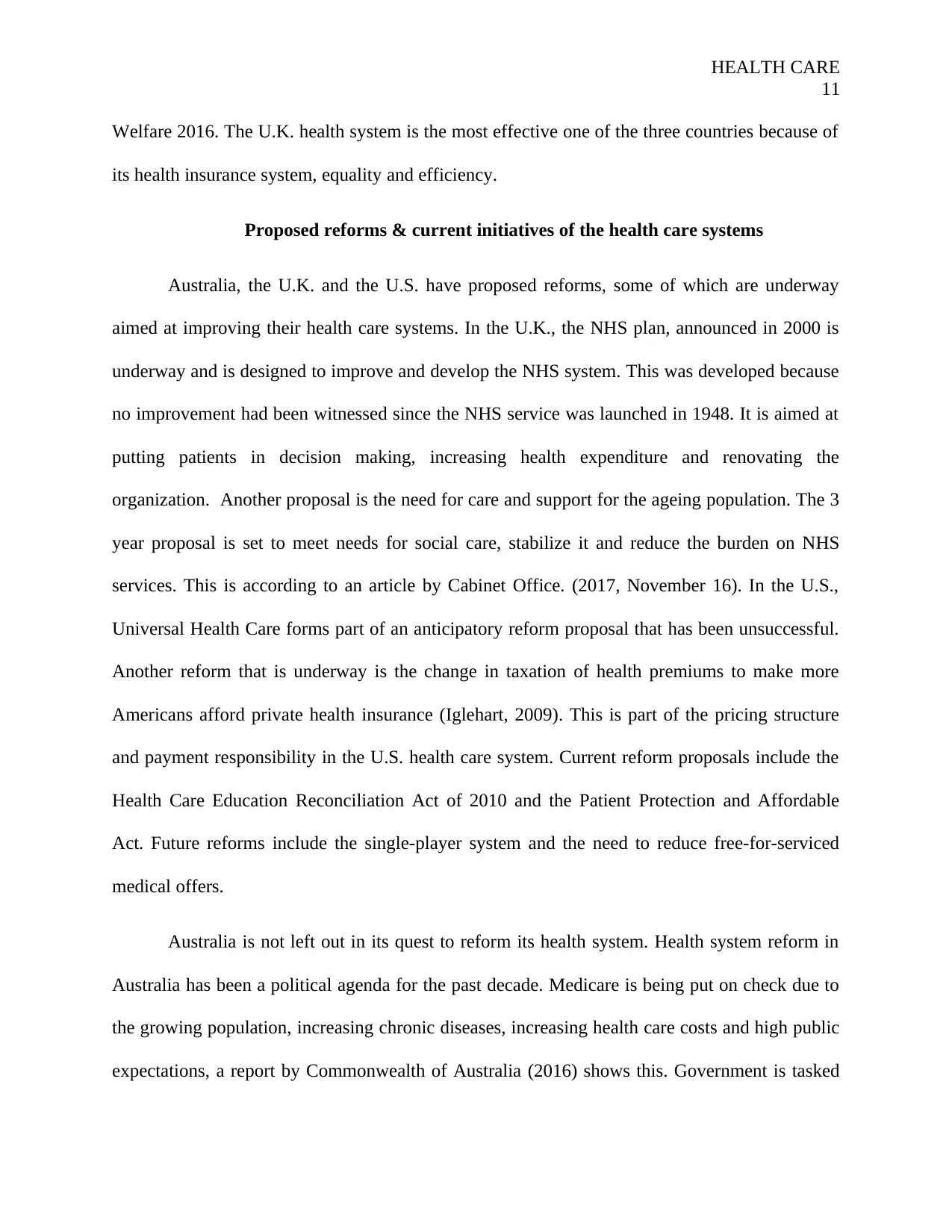
HEALTH CARE
11
Welfare 2016. The U.K. health system is the most effective one of the three countries because of
its health insurance system, equality and efficiency.
Proposed reforms & current initiatives of the health care systems
Australia, the U.K. and the U.S. have proposed reforms, some of which are underway
aimed at improving their health care systems. In the U.K., the NHS plan, announced in 2000 is
underway and is designed to improve and develop the NHS system. This was developed because
no improvement had been witnessed since the NHS service was launched in 1948. It is aimed at
putting patients in decision making, increasing health expenditure and renovating the
organization. Another proposal is the need for care and support for the ageing population. The 3
year proposal is set to meet needs for social care, stabilize it and reduce the burden on NHS
services. This is according to an article by Cabinet Office. (2017, November 16). In the U.S.,
Universal Health Care forms part of an anticipatory reform proposal that has been unsuccessful.
Another reform that is underway is the change in taxation of health premiums to make more
Americans afford private health insurance (Iglehart, 2009). This is part of the pricing structure
and payment responsibility in the U.S. health care system. Current reform proposals include the
Health Care Education Reconciliation Act of 2010 and the Patient Protection and Affordable
Act. Future reforms include the single-player system and the need to reduce free-for-serviced
medical offers.
Australia is not left out in its quest to reform its health system. Health system reform in
Australia has been a political agenda for the past decade. Medicare is being put on check due to
the growing population, increasing chronic diseases, increasing health care costs and high public
expectations, a report by Commonwealth of Australia (2016) shows this. Government is tasked
11
Welfare 2016. The U.K. health system is the most effective one of the three countries because of
its health insurance system, equality and efficiency.
Proposed reforms & current initiatives of the health care systems
Australia, the U.K. and the U.S. have proposed reforms, some of which are underway
aimed at improving their health care systems. In the U.K., the NHS plan, announced in 2000 is
underway and is designed to improve and develop the NHS system. This was developed because
no improvement had been witnessed since the NHS service was launched in 1948. It is aimed at
putting patients in decision making, increasing health expenditure and renovating the
organization. Another proposal is the need for care and support for the ageing population. The 3
year proposal is set to meet needs for social care, stabilize it and reduce the burden on NHS
services. This is according to an article by Cabinet Office. (2017, November 16). In the U.S.,
Universal Health Care forms part of an anticipatory reform proposal that has been unsuccessful.
Another reform that is underway is the change in taxation of health premiums to make more
Americans afford private health insurance (Iglehart, 2009). This is part of the pricing structure
and payment responsibility in the U.S. health care system. Current reform proposals include the
Health Care Education Reconciliation Act of 2010 and the Patient Protection and Affordable
Act. Future reforms include the single-player system and the need to reduce free-for-serviced
medical offers.
Australia is not left out in its quest to reform its health system. Health system reform in
Australia has been a political agenda for the past decade. Medicare is being put on check due to
the growing population, increasing chronic diseases, increasing health care costs and high public
expectations, a report by Commonwealth of Australia (2016) shows this. Government is tasked
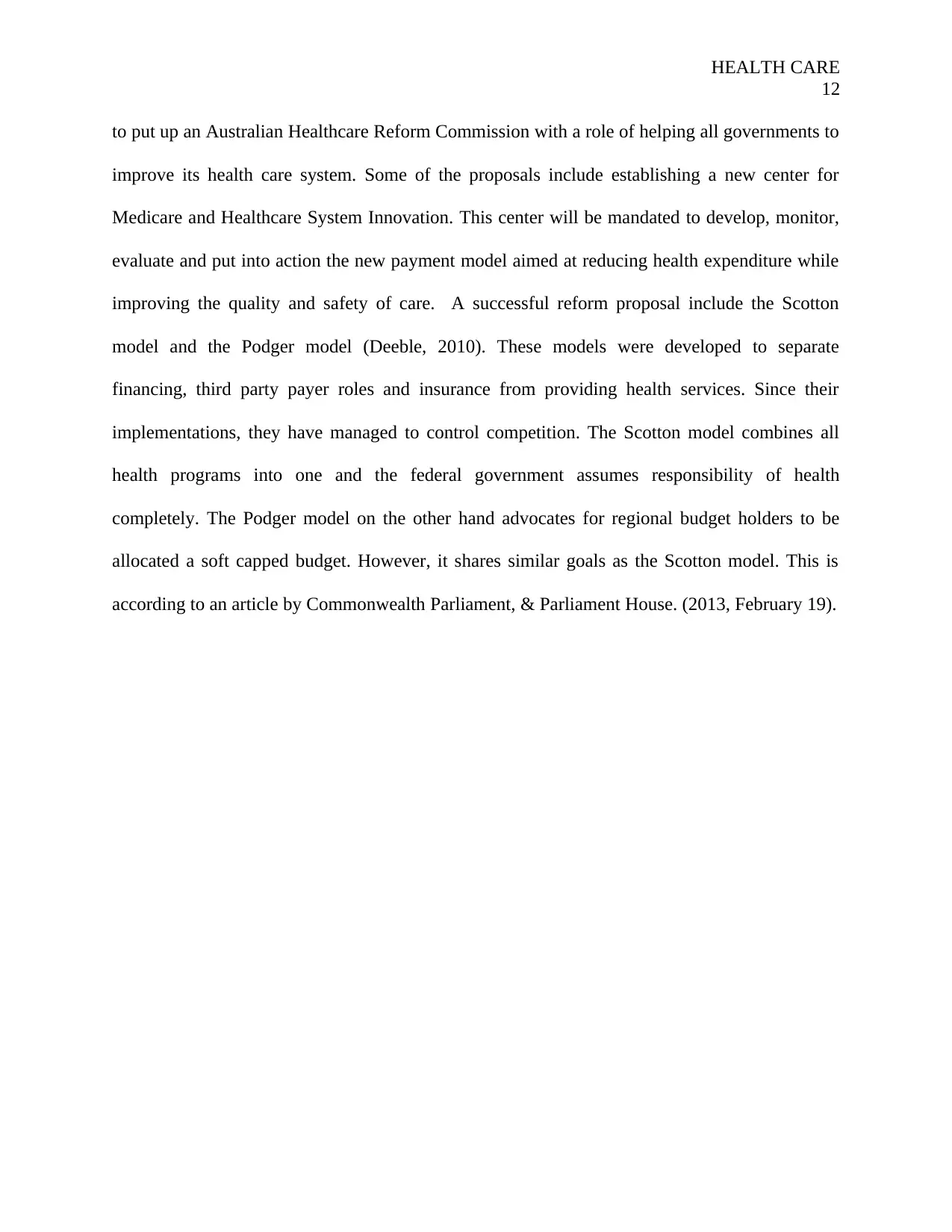
HEALTH CARE
12
to put up an Australian Healthcare Reform Commission with a role of helping all governments to
improve its health care system. Some of the proposals include establishing a new center for
Medicare and Healthcare System Innovation. This center will be mandated to develop, monitor,
evaluate and put into action the new payment model aimed at reducing health expenditure while
improving the quality and safety of care. A successful reform proposal include the Scotton
model and the Podger model (Deeble, 2010). These models were developed to separate
financing, third party payer roles and insurance from providing health services. Since their
implementations, they have managed to control competition. The Scotton model combines all
health programs into one and the federal government assumes responsibility of health
completely. The Podger model on the other hand advocates for regional budget holders to be
allocated a soft capped budget. However, it shares similar goals as the Scotton model. This is
according to an article by Commonwealth Parliament, & Parliament House. (2013, February 19).
12
to put up an Australian Healthcare Reform Commission with a role of helping all governments to
improve its health care system. Some of the proposals include establishing a new center for
Medicare and Healthcare System Innovation. This center will be mandated to develop, monitor,
evaluate and put into action the new payment model aimed at reducing health expenditure while
improving the quality and safety of care. A successful reform proposal include the Scotton
model and the Podger model (Deeble, 2010). These models were developed to separate
financing, third party payer roles and insurance from providing health services. Since their
implementations, they have managed to control competition. The Scotton model combines all
health programs into one and the federal government assumes responsibility of health
completely. The Podger model on the other hand advocates for regional budget holders to be
allocated a soft capped budget. However, it shares similar goals as the Scotton model. This is
according to an article by Commonwealth Parliament, & Parliament House. (2013, February 19).
⊘ This is a preview!⊘
Do you want full access?
Subscribe today to unlock all pages.

Trusted by 1+ million students worldwide
1 out of 16
Related Documents
Your All-in-One AI-Powered Toolkit for Academic Success.
+13062052269
info@desklib.com
Available 24*7 on WhatsApp / Email
![[object Object]](/_next/static/media/star-bottom.7253800d.svg)
Unlock your academic potential
Copyright © 2020–2025 A2Z Services. All Rights Reserved. Developed and managed by ZUCOL.




